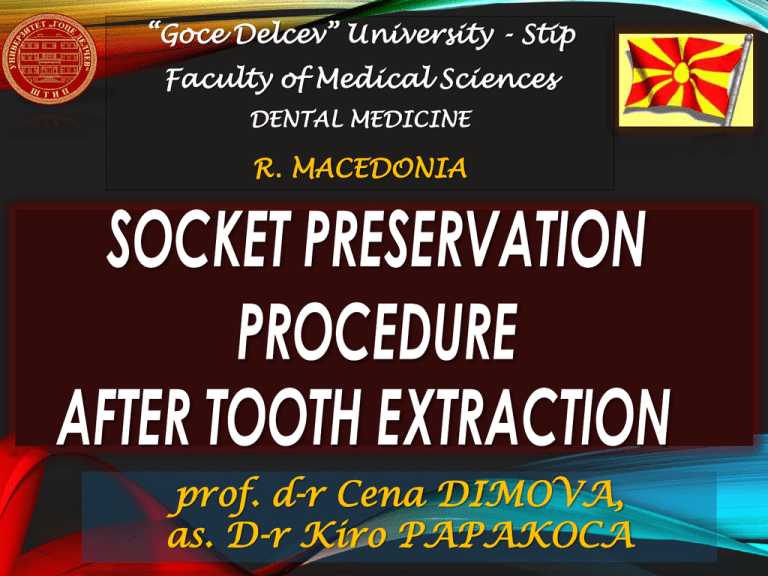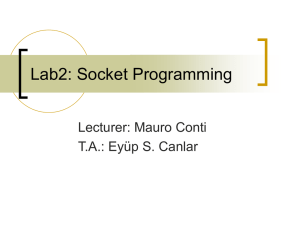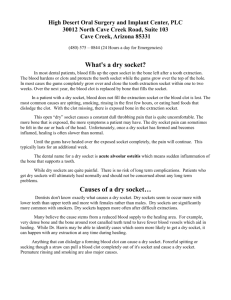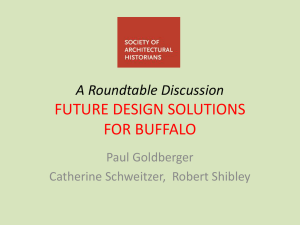Document
advertisement

“Goce Delcev” University - Stip Faculty of Medical Sciences DENTAL MEDICINE R. MACEDONIA prof. d-r Cena DIMOVA, as. D-r Kiro PAPAKOCA INTRODUCTION SEVEN IMPORTANT QUESTIONS TO THE SOCKET PRESERVATION EVIDENCE OF SOCCET PRESERVATION INTRODUCTION • After tooth extraction, the residual alveolar ridge generally provides limited bone volume because of ongoing, progressive bone resorption. • Healing events within postextraction sockets reduce the dimensions of the socket over time. • As dentists, we hear a lot about implants and bone grafting. We hear a lot about sinus lifts and ridge grafting. • Extraction socket preservation has not been given the attention it deserves. Unfortunately for our patients, most of us are not grafting extraction sites to preserve the alveolar bone. • The following discussion should help to answer some basic questions about socket preservation and hopefully help us all to consider providing this as a service to our patients. INTRODUCTION SEVENN IMPORTANT QUESTIONS TO THE SOCKET PRESERVATION EVIDENCE OF SOCCET PRESERVATION THERE ARE 7 IMPORTANT QUESTIONS TO THIS DISCUSSION: 1. What is extraction socket preservation? 2. Is it a difficult procedure? 3. What is the benefit to the patient? 4. What are the consequences of not grafting? 5. Who should be performing this procedure? 6. What is the benefit to the dentist? 7. Is socket preservation the standard of care? WHAT IS EXTRACTION SOCKET PRESERVATION? • The process begins with atraumatic tooth extraction. • Every attempt is made to preserve the surrounding bone and soft tissue, with an emphasis on being careful not to fracture the delicate buccal plate. • There are a number of techniques and instruments that aid in this process. • In general, one never wants to elevate so that force is directed toward the buccal plate. • Once the tooth is extracted, all the granulation tissue is removed from the socket. • It is important that good bleeding is established in the socket. IS IT A DIFFICULT PROCEDURE? Absolutely not! It is much more difficult to do a good composite restoration than it is to graft a socket. • bone remodeling after the extraction • alveolar preservation and augmentation • Implantation after bone remodeling Implantation after alveolar preservation and augmentation Therefore, without grafting, there is a higher likelihood that a ridge lap type restoration or a “long pontic” would be necessary to fill in the space of the resorbed socket and ridge. We do not have to accept these compromised esthetic results. We have all dealt, prosthetically, with the effects of a ridge collapse. The surgery to correct these defects is many times more difficult, expensive and less predictable than grafting the socket initially. These defects are preventable for the most part. WHO SHOULD BE PERFORMING THIS PROCEDURE? • Every practicing dentist is capable of socket preservation procedures. If you are comfortable extracting a tooth, you 100% can and should graft the socket. Every dentist owes it to their patients to offer this service. WHAT IS THE BENEFIT TO THE DENTIST? • You are providing the best possible care to your patients. The result will be fewer restorative challenges and better functional and esthetic results. It is what we all strive to achieve. • You are learning a new and interesting procedure, which is something we all like to do. Socket grafting will also add significantly to your income. IS SOCKET PRESERVATION THE STANDARD OF CARE? As of now, each practitioner must answer this question for him or herself. Based on the points in section one If it were you, would you want a ridge preservation procedure performed at the time of tooth removal? CONCLUSION it is the standard of care to offer socket preservation and to explain the potential consequences of not grafting. If someone chooses not to graft an extraction site, be careful to clearly document it in his chart. It is only a matter time that it will become the standard of care.











